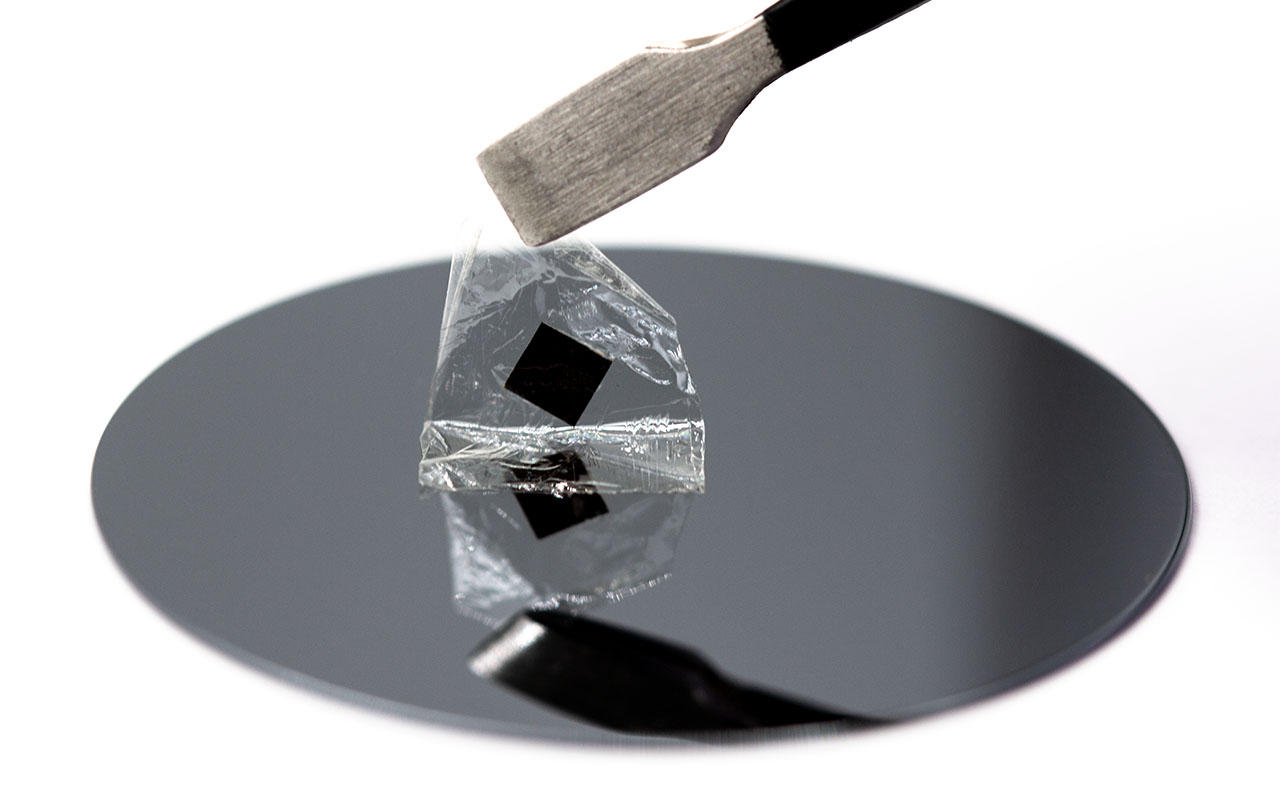(New fabrication method brings single-crystal perovskite devices closer to viability)
2020/7/29 アメリカ合衆国・カリフォルニア大学サンディエゴ校(UCSD)

・ UCSD が、標準的な半導体製造プロセスを利用し、面積、薄さと組成を正確に調整したフレキシブルな単結晶質ペロブスカイト薄膜の新製造技術を開発。
・ 半導体材料の一種であるペロブスカイトは、多結晶質のものに比べて単結晶質薄膜で欠陥がほとんどなく、優れた電子・光学特性を提供する。太陽電池、オプティカルファイバーや LED ベースのデバイス等の光伝播・検出デバイスや光を制御するデバイスでの利用に適している。
・ 携帯電話、コンピューターや衛星等の現代のエレクトロニクスでは、シリコンやガリヒ素等の材料の単結晶薄膜がベースとなっている。欠陥の少ない単結晶構造では多結晶構造よりも優れた電子輸送性能を示すが、他のコンポーネントへデバイスを統合するためには薄膜であること、そのプロセスがスケーラブル、低コストで既存の工業規格に適合することが重要。
・ 製造中に単結晶質ペロブスカイトの構造や組成を制御することがこれまでは困難であったが、リソグラフィーを始めとする従来の半導体製造プロセスを活用してこの問題を克服した。
・ 同大学は、2018 年に産業用リソグラフィープロセスへのペロブスカイトの導入に初めて成功。保護層のドライエッチング後にポリマーの保護層を追加することで、リソグラフィーで利用する水によるぺロブスカイトへの影響を回避した。
・ 今回、縦横の両寸法を調整するマスクパターンを設計し、ペロブスカイトのバルク結晶基板上で単結晶ペロブスカイトの成長を制御する手法を開発。単結晶層の構造と基板への粘着性を維持したまま、バルク基板から他の基板へ転写する。
・ 鉛からスズへと組成に勾配付した混合物を成長溶液に添加することで単結晶薄膜のバンドギャップに傾斜を付与し、電子移動度の向上とキャリアの再結合の回避を図った。同製造プロセスでは、600nm~100μm の薄さと、厚さ方向での組成勾配を調整しながら最大で 5.5 ㎠の単結晶薄膜が作製できる。
・ 今後は、同プロセスのさらなる合理化と転写歩留りの向上を図る。パターンマスクを電子輸送層に置き換えて転写のステップを省略することで、製造歩留りが大幅に向上できると考える。
・ 本研究は、UCSD のスタートアップファンドおよび California Energy Commission アワードの支援により実施された。
URL: https://ucsdnews.ucsd.edu/pressrelease/new-fabrication-method-brings-single-crystalperovskite-devices-closer-to-viability
(関連情報)
Nature 掲載論文(アブストラクトのみ:全文は有料)
A fabrication process for flexible single-crystal perovskite devices
URL: https://www.nature.com/articles/s41586-020-2526-z
<NEDO海外技術情報より>
Abstract
Organic–inorganic hybrid perovskites have electronic and optoelectronic properties that make them appealing in many device applications1,2,3,4. Although many approaches focus on polycrystalline materials5,6,7, single-crystal hybrid perovskites show improved carrier transport and enhanced stability over their polycrystalline counterparts, due to their orientation-dependent transport behaviour8,9,10 and lower defect concentrations11,12. However, the fabrication of single-crystal hybrid perovskites, and controlling their morphology and composition, are challenging12. Here we report a solution-based lithography-assisted epitaxial-growth-and-transfer method for fabricating single-crystal hybrid perovskites on arbitrary substrates, with precise control of their thickness (from about 600 nanometres to about 100 micrometres), area (continuous thin films up to about 5.5 centimetres by 5.5 centimetres), and composition gradient in the thickness direction (for example, from methylammonium lead iodide, MAPbI3, to MAPb0.5Sn0.5I3). The transferred single-crystal hybrid perovskites are of comparable quality to those directly grown on epitaxial substrates, and are mechanically flexible depending on the thickness. Lead–tin gradient alloying allows the formation of a graded electronic bandgap, which increases the carrier mobility and impedes carrier recombination. Devices based on these single-crystal hybrid perovskites show not only high stability against various degradation factors but also good performance (for example, solar cells based on lead–tin-gradient structures with an average efficiency of 18.77 per cent).



